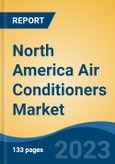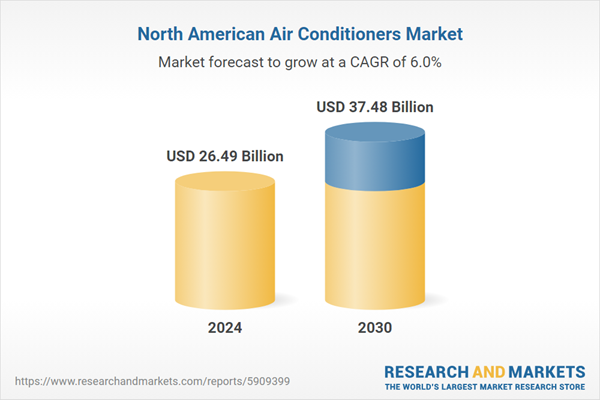Speak directly to the analyst to clarify any post sales queries you may have.
10% Free customizationThis report comes with 10% free customization, enabling you to add data that meets your specific business needs.
Energy Information Administration’s (EIA) Residential Energy Consumption Survey (RECS) provides comprehensive data on air-conditioning equipment and electricity usage in U.S. households. The 2020 survey revealed that air conditioning accounted for 19% of household electricity consumption, equivalent to 254 billion kilowatt-hours (kWh). This data is accessible by state through the RECS Dashboard. The region’s strong focus on technological innovation and growing emphasis on eco-friendly alternatives contribute to the increasing demand for advanced cooling solutions. Major players in the market continue to enhance product offerings to meet diverse consumer needs.
Key Market Drivers
Technological Advancements and Smart Air Conditioners
The integration of smart technologies into air conditioning systems is another major driver of market growth. Consumers are increasingly looking for products that offer convenience, control, and automation, and air conditioners are no exception. The advent of smart air conditioners that can be controlled remotely via smartphones, tablets, and voice assistants (like Amazon Alexa or Google Assistant) is transforming how people manage their indoor climate.These smart systems allow users to set temperature schedules, control air quality, and monitor energy consumption more efficiently, offering personalized comfort. Furthermore, the integration of Internet of Things (IoT) technology in air conditioning systems enables predictive maintenance. Through IoT-enabled features, air conditioners can alert users to potential issues before they become costly repairs, increasing the longevity of the units.
Rising Temperatures and Climate Change
Another significant driver of the North America air conditioners market is the increasing occurrence of extreme weather conditions and rising temperatures due to climate change. According to reports from organizations such as the National Oceanic and Atmospheric Administration (NOAA), temperatures in North America have been steadily increasing, contributing to more frequent heatwaves. This phenomenon is increasing the demand for air conditioning systems as people seek reliable cooling solutions to stay comfortable and healthy during hot weather. According to the International Energy Agency (IEA), nearly all U.S. homes now have air conditioning, with 97% of newly built homes equipped with AC units. This growing reliance on cooling solutions significantly propels market growth.In both urban and suburban areas, high temperatures often coincide with rising air pollution levels, making air conditioners not only necessary for cooling but also for improving air quality. Many modern air conditioners come equipped with filtration systems designed to reduce allergens, dust, and pollutants from the air, contributing to better indoor air quality. As climate change continues to cause extreme weather conditions, the demand for air conditioners is expected to remain high, especially in regions that traditionally had milder climates but are now experiencing more intense heatwaves.
Urbanization and Rising Disposable Income
Urbanization is another key factor driving the air conditioners market in North America. As cities grow and populations become denser, the demand for residential, commercial, and industrial cooling solutions continues to rise. In densely populated areas, where high-rise buildings and dense residential complexes are common, air conditioning is often essential to ensure a comfortable living and working environment.Rising disposable income in North America is also contributing to the increased adoption of air conditioners. As people’s incomes grow, so does their purchasing power, allowing them to invest in modern air conditioning systems that offer improved performance, greater energy efficiency, and advanced features. The affordability of air conditioners has been improving, and with financing options, consumers are more willing to invest in air conditioning solutions for their homes and businesses. The availability of financing and leasing options further supports the demand for air conditioners, particularly in high-income households and businesses that prioritize comfort and efficiency.
Key Market Challenges
High Initial Costs of Advanced Air Conditioning Systems
One of the primary challenges facing the North American air conditioners market is the high initial cost of advanced, energy-efficient, and smart air conditioning systems. Although these systems offer long-term savings in terms of energy consumption and maintenance, their upfront purchase price can be a significant barrier for many consumers, especially in the residential sector.Energy-efficient models, such as those with high SEER (Seasonal Energy Efficiency Ratio) ratings, and smart air conditioners with IoT capabilities come at a premium compared to traditional air conditioners. For instance, the integration of advanced sensors, Wi-Fi connectivity, and automated controls adds to the cost of manufacturing and, consequently, to the retail price of the product. Many consumers are hesitant to invest in these higher-priced systems, particularly in economically uncertain times when disposable income may be limited.
Environmental Impact of Refrigerants
The environmental impact of refrigerants used in air conditioning systems presents another significant challenge for the North American air conditioners market. Traditional refrigerants such as hydrofluorocarbons (HFCs) and chlorofluorocarbons (CFCs) have been linked to global warming and ozone depletion. In response to growing environmental concerns and tightening regulations, there has been a strong push to adopt more eco-friendly refrigerants, such as hydrofluoroolefins (HFOs) and natural refrigerants like CO2 and ammonia.While the transition to these more sustainable refrigerants is necessary for reducing the environmental footprint of air conditioners, it comes with challenges. The development and integration of new refrigerant technologies require significant investment in research, development, and manufacturing processes. Many older air conditioning units are not compatible with newer refrigerants, meaning that replacement or retrofitting is often required. This can lead to higher costs for consumers who are seeking to upgrade their units to more environmentally friendly models.
Key Market Trends
Increased Adoption of Energy-Efficient Air Conditioners
Energy efficiency continues to be a dominant trend in the North American air conditioners market. As concerns about energy consumption and climate change grow, both consumers and businesses are seeking ways to reduce their carbon footprints and lower energy costs. The rising cost of electricity and growing environmental awareness have led to a shift toward energy-efficient air conditioning systems.Manufacturers are responding by developing air conditioners with higher SEER (Seasonal Energy Efficiency Ratio) ratings, which indicate how efficiently the units cool a space compared to their energy consumption. These systems use advanced compressors, improved insulation, and smart thermostats to optimize energy usage, thus reducing the overall energy footprint. In addition, government regulations, such as ENERGY STAR certification in the U.S. and Canada, are pushing manufacturers to meet strict efficiency standards. These regulations incentivize consumers to purchase energy-efficient air conditioners by offering rebates and incentives, making them more affordable.
Increasing Demand for Commercial and Industrial Air Conditioning Systems
In addition to the residential market, the demand for air conditioning systems in commercial and industrial sectors is growing at a rapid pace in North America. The need for reliable cooling in offices, retail spaces, restaurants, and industrial facilities has driven significant growth in this segment of the market. As businesses place a higher emphasis on employee comfort and customer satisfaction, air conditioning has become a critical part of maintaining optimal working and shopping environments.Commercial and industrial air conditioning systems often require larger, more robust cooling solutions, including centralized HVAC (heating, ventilation, and air conditioning) systems. The trend toward building energy-efficient commercial spaces is also influencing this demand, as businesses seek to reduce their operating costs while ensuring the comfort of their employees and customers. The growth of the commercial real estate sector, especially in urban areas, is also contributing to the rising demand for cooling solutions.
Segmental Insights
End Use Insights
The residential segment was the dominating sector in the North American air conditioners market, driven by increasing consumer demand for home comfort and energy-efficient cooling solutions. Rising temperatures, especially in warmer regions, and the growing trend of homeownership contribute to the expansion of this segment. Additionally, advancements in energy-efficient and smart air conditioners, offering better temperature control and lower utility bills, attract homeowners seeking long-term savings. As climate change leads to more frequent heatwaves, residential air conditioning continues to be a priority investment for consumers, further solidifying its position as the largest and fastest-growing segment in the market.Country Insights
The United States was the dominant region in the North American air conditioners market due to its large population, high demand for cooling solutions, and significant urbanization. With increasing temperatures, particularly in southern and western states, the demand for air conditioning systems remains strong across residential, commercial, and industrial sectors. Additionally, the U.S. benefits from a robust economy, which drives consumer spending on advanced, energy-efficient air conditioning systems. Stringent environmental regulations and a growing focus on sustainability also contribute to the U.S. market's growth, making it a key player in the overall North American air conditioning landscape.Key Market Players
- Daikin U.S. Corporation
- Mitsubishi Electric US, Inc.
- Johnson Controls-Hitachi Air Conditioning North America LLC
- Carrier Global Corporation
- Whirlpool Corporation
- Haier US Appliance Solutions, Inc.
- LG Electronics U.S.A. Inc
- Panasonic Corporation of North America
- Robert Bosch LLC.
- Samsung Electronics America, Inc.
Report Scope:
In this report, the North America Air Conditioners Market has been segmented into the following categories, in addition to the industry trends which have also been detailed below:North America Air Conditioners Market, By Product Type:
- Splits
- VRFs
- Chillers
- Windows
- Others
North America Air Conditioners Market, By End Use:
- Residential
- Commercial/Industrial
North America Air Conditioners Market, By Country:
- United States
- Canada
- Mexico
Competitive Landscape
Company Profiles: Detailed analysis of the major companies present in the North America Air Conditioners Market.Available Customizations:
With the given market data, the publisher offers customizations according to a company's specific needs. The following customization options are available for the report.Company Information
- Detailed analysis and profiling of additional market players (up to five).
This product will be delivered within 1-3 business days.
Table of Contents
Companies Mentioned
- Daikin U.S. Corporation
- Mitsubishi Electric US, Inc.
- Johnson Controls-Hitachi Air Conditioning North America LLC
- Carrier Global Corporation
- Whirlpool Corporation
- Haier US Appliance Solutions, Inc.
- LG Electronics U.S.A. Inc
- Panasonic Corporation of North America
- Robert Bosch LLC.
- Samsung Electronics America, Inc.
Table Information
| Report Attribute | Details |
|---|---|
| No. of Pages | 135 |
| Published | February 2025 |
| Forecast Period | 2024 - 2030 |
| Estimated Market Value ( USD | $ 26.49 Billion |
| Forecasted Market Value ( USD | $ 37.48 Billion |
| Compound Annual Growth Rate | 6.0% |
| Regions Covered | North America |
| No. of Companies Mentioned | 10 |









